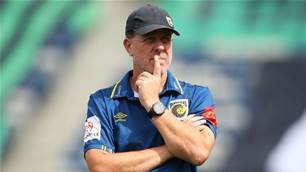Matildas coach Alen Stajcic has presided over one of the most remarkable rises in Australian sporting history – but he isn’t planning to stop with women’s football.
While it would be naïve to place the turnaround fortunes of women’s football in Australia on Stajcic’s shoulders, since the 45-year-old took over the national coaching role, the Matildas have become one of the highest-profile Australian sporting teams – winning the 2017 Tournament of Nations, their first knockout game at a World Cup, rising to a high of fourth in the world and spawning some of the game’s finest contemporary footballers; most notably Sam Kerr.
It’s an upsurge that has not only captured the Australian sporting public’s imagination, but re-evaluated what Australia could expect from the beautiful game. Which is why for Stajcic, the battle has only just begun.
“Around the world, female football is developing at a rapid rate,” Stajcic told The Women’s Game podcast. “It’s going to be a tough challenge for any nation that drops off.
“(The Matildas) have an open door policy for coaches and former players to come in and see how we train - there is a lot of learning available to coaches so they can, and I emphasise, realise the level that is required at the top of the world.
“At the end of the day, at this level, it’s about bringing in quality people who have a lot to give.
“We all have a lot to learn, it’s not really about male or female, it’s about giving people that exposure. That’s the way we’ll raise the standard of football in this country, not just for females but for males as well.”
LISTEN TO THE FULL CHAT HERE
AND SUBSCRIBE ON ITUNES HERE NOW...
Now combatting the weight of expectation, the Matildas face the sternest test of Stajcic’s reign in 2019. At the 2015 World Cup, a quarter-final knockout against Japan was seen as a fantastic achievement. Four years later, it will be the bare minimum.
The side’s stars are now entering a physical and mental peak: Alanna Kennedy has 74 caps at just 23-years-old, while Kerr and Emily van Egmond boast 72 and 82 caps respectively at 25.
Stajcic’s squad boast a plethora of international experience, but, more than ever, face the pressure to perform.
There are now a new set of challenges on the horizon.
“All our younger players have to compete against four or five internationals that come in to every W-League team,” Stajcic said. “A W-League coach is always going to pick the best players.
“We lost a lot when we lost the (player development) institute structures in 2012. We had a solid base where players could train full time with psych and conditioning.
“When we lost that, we lost the resources that our young players needed. The Future Matildas program goes someway to repairing that, but it’s only lasted one year so far. We haven’t qualified for a Youth World Cup since 2006.
“We’ll now have 20-30 players we can train full-time, under our eye. Each of these players are in the running. But the most important aspect is their development, expose them to the level they need to get to.
“You can see the benefits (of the Future Matildas) already through the likes of Princess Ibini and Larissa Crummer. If we can have that kind of program that sees the production line continuing, producing one to two new Matildas every year, then we’ll be in good shape.”
After “15 years living” within the chaotic world of Australian football governance, ‘Staj’ has overseen his fair share of challenges. But most importantly for the keen-eyed coach, so have his team.
“Having lived in the organisation for the past 15 years, I’ve got to see first-hand the change in mentality in FFA and the way women’s football is perceived,” he continued.
LISTEN TO THE FULL CHAT HERE
AND SUBSCRIBE ON ITUNES HERE NOW...
“It is very equal in the amount of care and resources across the board. Socceroos and Matildas games get the same amount of care and detail.
“Everyone in the hierarchy knows how much I nag, but it really has been a delight to see how much people’s attitudes have shifted and it’s obvious to see the change. We can call upon virtually the same level of staff that Socceroos can.
“Mental strength is the extra element that we need to work on. That was (Matildas record cap-holder) Cheryl Salisbury – she had that presence to influence people around her – that’s the yardstick that people in our team use.
“I’ve never seen a single successful career that’s had a linear progression, it’s the people who fight back when all seems lost.
“You only have to look at the things our team have had to go through, the challenges they’ve faced, to see how important this is.
“The people who rise to the top of the world are those who pick themselves up most often.”
Related Articles

Stajcic lands Wanderers job as Lederer quits

'We're dreaming': Miracle man Stajcic hunts more scalps













